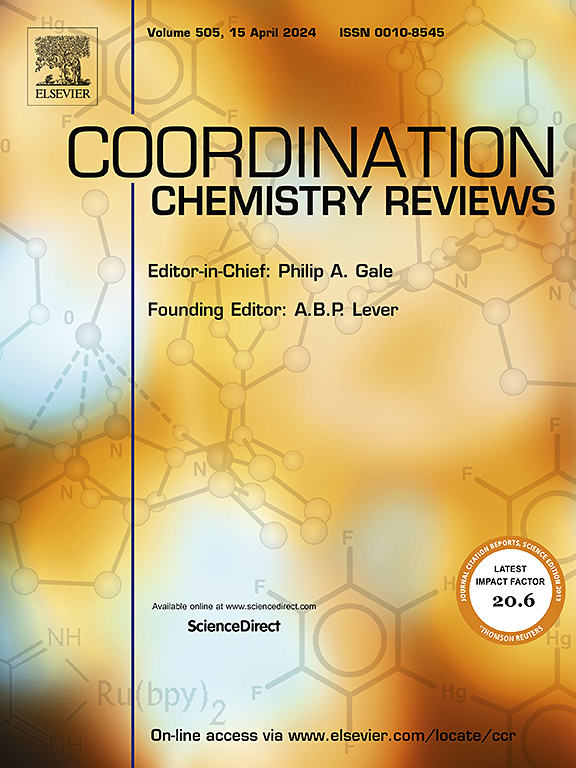In vitro and in vivo bioimaging by Quinoline conjugated probes and dyes
IF 20.3
1区 化学
Q1 CHEMISTRY, INORGANIC & NUCLEAR
引用次数: 0
Abstract
Bioimaging has emerged as an admirable technique for the early-stage detection of diseases that are difficult to drive backwards in the advanced stages, such as cancer and Alzheimer's disease. It provides a non-invasive approach for gathering information on the progress or reoccurrence of these diseases. However, smart fluorescent dyes are essential for bioimaging, allowing real-time visualization and tracking of biological processes. Fluorescent dyes or fluorophores absorb and emit light at two different wavelengths to generate fluorescence. They predominantly belong to small organic molecules and remain indispensable tools in scientific research. The most widely employed organic dyes in bioimaging applications are rhodamine, coumarin, fluorescein, cyanine, resorufin, BODIPY, quinoline, and Alexa Fluor dyes. Among them, quinoline-conjugated probes and dyes offer several advantages for bioimaging due to their unique structural and photophysical properties. Their tunable fluorescence properties, environmental sensitivity, enhanced photostability, NIR emission, high quantum yields, selective targeting, binding ability, minimal cytotoxicity, and versatility in sensing mechanisms provide unique advantages in multiplex imaging. Besides, fluorescent labelling with several traditional dyes significantly impacts the parent biological properties. However, such adverse effects are less experienced with quinoline dyes due to their excellent biocompatibility. In addition, cationic quinoline conjugates have been found to improve water solubility and mitochondria targeting ability. Therefore, they become excellent choices for imaging purposes. Moreover, quinoline-based probes show excellent molecular recognition properties. Scientists have highlighted their sensing abilities recently but have not adequately emphasized their imaging capabilities. Herein, we have comprehensively discussed almost 170 quinoline-conjugated molecules for their in vitro and in vivo imaging applications. We have confined our discussion to quinoline conjugates that are capable of bioimaging. Significantly, quinoline moiety plays an important role in these conjugates to improve their bioimaging performance. Appropriately, we have carefully classified these probes and dyes according to the role played by the quinoline unit. This will provide an important vision of using quinoline moiety to improve the performance of newly designed molecules for bioimaging applications. We hope this review will encourage researchers and young scientists to develop new generation quinoline conjugated dyes with superior bioimaging ability in the future.

利用喹啉共轭探针和染料进行体外和体内生物成像
本文章由计算机程序翻译,如有差异,请以英文原文为准。
求助全文
约1分钟内获得全文
求助全文
来源期刊

Coordination Chemistry Reviews
化学-无机化学与核化学
CiteScore
34.30
自引率
5.30%
发文量
457
审稿时长
54 days
期刊介绍:
Coordination Chemistry Reviews offers rapid publication of review articles on current and significant topics in coordination chemistry, encompassing organometallic, supramolecular, theoretical, and bioinorganic chemistry. It also covers catalysis, materials chemistry, and metal-organic frameworks from a coordination chemistry perspective. Reviews summarize recent developments or discuss specific techniques, welcoming contributions from both established and emerging researchers.
The journal releases special issues on timely subjects, including those featuring contributions from specific regions or conferences. Occasional full-length book articles are also featured. Additionally, special volumes cover annual reviews of main group chemistry, transition metal group chemistry, and organometallic chemistry. These comprehensive reviews are vital resources for those engaged in coordination chemistry, further establishing Coordination Chemistry Reviews as a hub for insightful surveys in inorganic and physical inorganic chemistry.
 求助内容:
求助内容: 应助结果提醒方式:
应助结果提醒方式:


